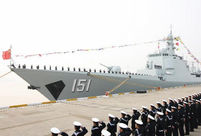 'Jin' named the word of the year by cross-strait netizens
'Jin' named the word of the year by cross-strait netizens Chinese scientific expedition goes to build new Antarctica station
Chinese scientific expedition goes to build new Antarctica station
 Chinese naval escort fleet conducts replenishment in Indian Ocean
Chinese naval escort fleet conducts replenishment in Indian Ocean 17th joint patrol of Mekong River to start
17th joint patrol of Mekong River to start China's moon rover, lander photograph each other
China's moon rover, lander photograph each other Teaming up against polluters
Teaming up against polluters
BEIJING, Jan. 4 -- Due to seasonal factors and structural issues, China's interbank lending rates spiked at the year-end, but posed no major risk to the country's economic growth for 2014, HSBC said in a report.
"We still expect growth to stabilize at around 7.5 percent in 2014, given that the (interbank lending) rate spikes should normalize and thus have a limited impact on investment," HSBC China economists Qu Hongbin and Sun Junwei said in the report published on Friday.
Interbank lending rates spiked again over Christmas to a half-year high, which forced the People's Bank of China (PBOC, central bank) to intervene to calm the market via reverse repurchase (repo).
On Dec. 23, the 7-day interbank repo rate jumped to an intraday high of nearly 10 percent, from around 4.5 percent on Dec. 17. The 14-day interbank repo rate jumped to 9.5 percent on Dec. 23 from around 4.6 percent on Dec. 17.
A day later, the PBOC intervened with the reverse repo operation, pumping 29 billion yuan into the banking system. As a result, rates started to normalize to below 6 percent on Dec. 25.
But at the current level of around 5 percent, the rates are still much higher than the average of around 4 percent over the first 11 months of 2013, Qu and Sun said in the report.
They attributed the rates spike partly to seasonal factors, such as banks preparing to meet year-end regulatory requirements, and a smaller-than-usual year-end boost in fiscal disbursements.
"But it is also symptomatic of structural problems, with financial institutions, especially the smaller banks, having become more reliant on short-term interbank borrowing to finance long-term lending, resulting in a worsening duration mismatch between liabilities and assets," they said.
It was the second time in 2013 for Chinese banks to encounter spikes in interbank lending rates. In June, the 7-day Shanghai Interbank Offered Rate (Shibor), which measures the rate at which Chinese banks lend to one another, hit a record high of over 13 percent.
Qu and Sun maintained that China's money market rates are likely to remain elevated in the near term, due to the demand for cash ahead of Chinese New Year, which falls on Jan. 31, and the banks' desire to ramp up lending at the start of the calendar year.
In addition, the PBOC has to strike a delicate balance between avoiding a repeat of the June 2013 cash crunch and ensuring it does not encourage commercial banks to continue to leverage up, they said.
Rising short-term interbank lending rates have lifted government bond yields, therefore pushing up the cost of funding for bond issuance -- which accounts for around 11 percent of total financing for the real economy, they said.
"However, the cost of bank loans, measured by either preferable lending rate or the weighted average lending rate, remains largely stable."
More importantly, the PBOC is expected to target around 13-percent credit growth this year, which should be adequate to support around 7.5-percent year-on-year GDP growth, they said.
Apart from credit growth, the gradually-improving external outlook, steady investment expansion and resilient consumer spending should keep China growing steadily in the coming quarters.
Moreover, with the government delivering reforms, the power of private consumption and investment demand could be unleashed sooner than many expect, they added.
 Chinese Consulate General in S.F. burned for arson attack
Chinese Consulate General in S.F. burned for arson attack Roar of J-15 fighter is melody for operator on the Liaoning
Roar of J-15 fighter is melody for operator on the Liaoning A 90-year-old forester's four decades
A 90-year-old forester's four decades Most touching moments in 2013
Most touching moments in 2013 2013: Joys and sorrows of world politicians
2013: Joys and sorrows of world politicians Missile destroyer Zhengzhou commissioned to Chinese navy
Missile destroyer Zhengzhou commissioned to Chinese navy China is technically ready to explore Mars
China is technically ready to explore Mars Photo story: Life changed by mobile technology
Photo story: Life changed by mobile technology Bullet train attendants' Christmas Eve
Bullet train attendants' Christmas Eve Most touching moments in 2013
Most touching moments in 2013 Chinese helicopter saves 52 in Antarctica
Chinese helicopter saves 52 in Antarctica PLA self-propelled guns firing in drill
PLA self-propelled guns firing in drill Those That Shaped 2013
Those That Shaped 2013 Yearender: Animals' life in 2013
Yearender: Animals' life in 2013 Hello 2014 - Chinese greet the New Year
Hello 2014 - Chinese greet the New YearDay|Week|Month